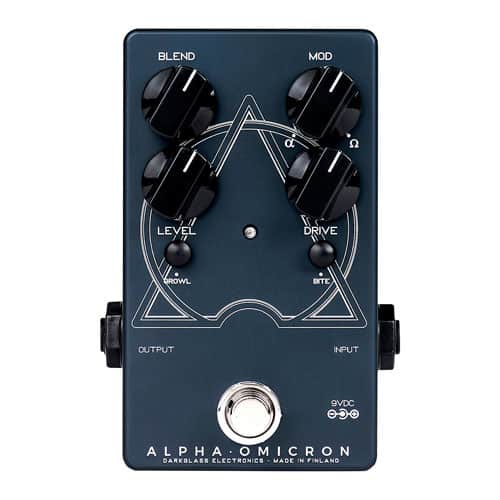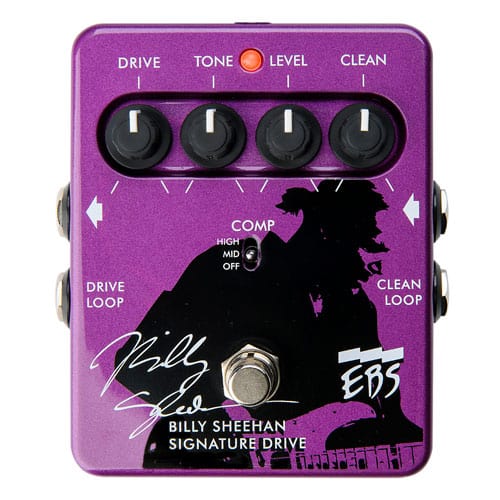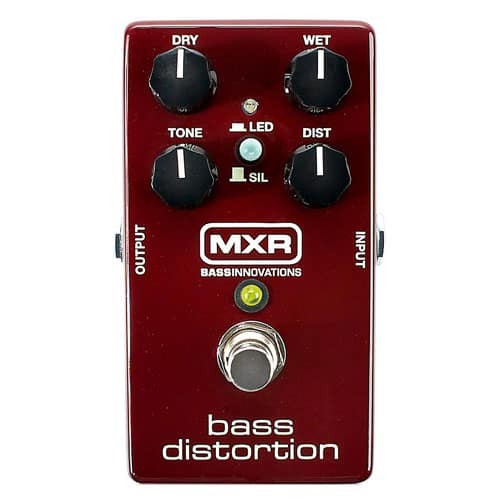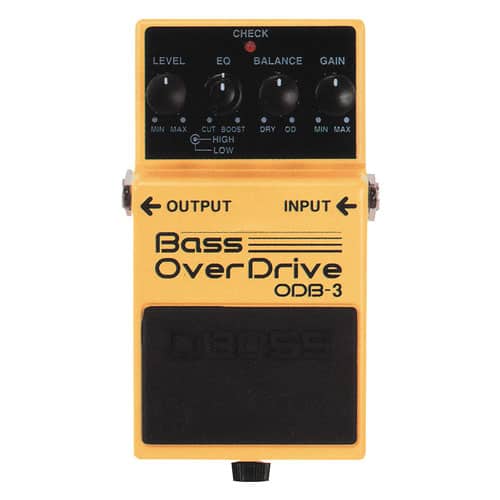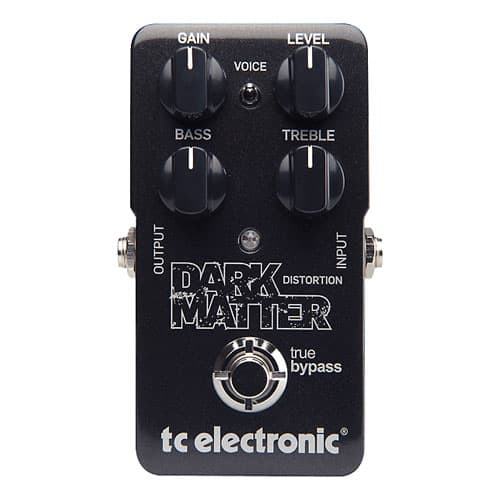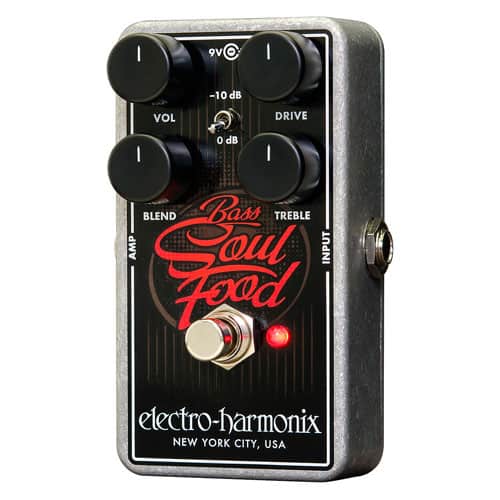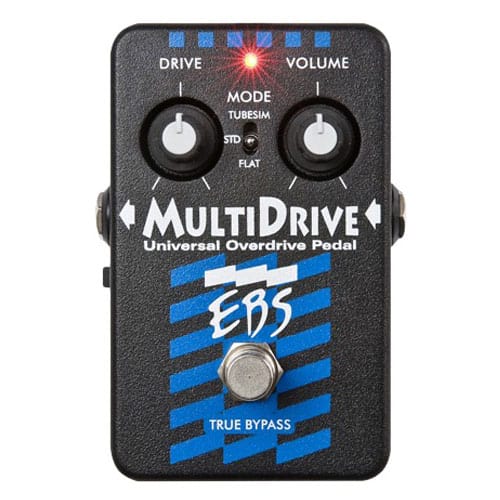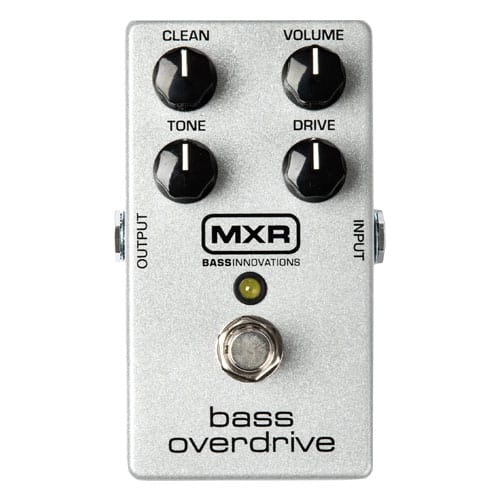Table of Contents
The bass guitar is very often a woefully underappreciated instrument. Many times – when played well – it locks in with the drummer to create a backbone where it sometimes isn’t even noticed.
That’s not necessarily a bad thing, but that’s gotta be frustrating at times for any bass player that’s worth a low-frequency rumble.
One way to make yourself stand out is the way you approach your bass lines. You can get all melodic and busy (check out McCartney in ‘Something’), or you can distinguish yourself by having a unique tonal palette that really sets you aside from the pack.
How can you do that, you ask?
Add in some bass effects! Having a distortion pedal is a great way to have your bass cut through the mix and make sure you’re noticed. I mean, really – why should those pesky six-string guitar players have all the fun?!?
Just ask Cliff Burton from Metallica – ‘Anesthesia (Pulling Teeth)’ is an extreme example, but even players such as Chris Squire from Yes likes a little dirt on their tone every now and then.
I’ve got you covered by taking a look at 9 of the best bass distortion pedals on the market today.
So, without further ado… let’s dig in!
The 9 Best bass Distortion pedals:
| Image | Bass Guitars | Summary | Check Price |
|---|---|---|---|
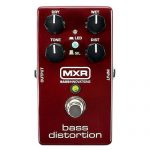 | MXR M85 Bass Distortion | Best Value: Awesome analog tone and adjustability, while also being quite affordable | Check price |
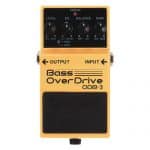 | Boss ODB-3 Bass Overdrive | Bulletproof Build Quality: Boss pedals are known to take a lot of abuse, the sound quality is pretty darn good too | Check price |
 | TC Electronics Dark Matter Distortion | Rich Tonal Range: Fully analog in design with a large tonal range, from slight grit to complete mayhem | Check price |
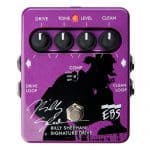 | EBS Billy Sheehan Signature Drive | Premium Pick: Billy Sheehan’s legendary overdrive tone with a compressor built-in for the ultimate punch | Check price |
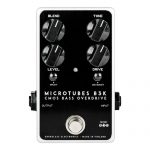 | Darkglass Microtubes BK3 V2 Bass Overdrive | Unique Sound Profile: Features like the mid-boost and grunt control open up a wide range of tonal possibility | Check price |
 | Electro-Harmonix Bass Soul Food | Keeping It Clean: Based on the popular soul food guitar pedal, the aim is to allow more natural tones to shine through | Check price |
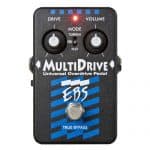 | EBS MultiDrive Universal Overdrive | Simple Interface: Although not many knobs to adjust, the mode switch offers a lot of interesting flavor | Check price |
 | MXR M89 Bass Overdrive | Classic Tube Drive: Aimed more at producing that vintage sound normally found in slightly overdriven amps | Check price |
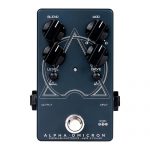 | Darkglass Alpha Omicron Bass Distortion | Best Choice: Two distortion circuits which can be blended together for the ultimate growling bass guitar | Check price |
MXR M85 Bass Distortion Pedal
MXR has well deserved reputation for high-quality pedals, and thanks to a powerful feature set the M85 is yet another great example of what the company is all about.
Based off a collaboration with Ryan Ratajski from Fuzzrocious Pedals, the M85 packs a lot of functionality into it’s small footprint.
A big feature is the ability to control wet and dry signal levels, giving a level of flexibility that may be hard to find in many other pedals.
Yet another plus is the ‘diode type’ selection setting. You can choose either a silicon clipping diode based signal path for tighter sounds, or go with the LED diode setting for a more spacious sound with some gain boost as well.
Positives
- Individual level controls for both wet and dry signals let you blend your sound exactly to your taste
- A unique diode selection mode that broadly opens up your options; it’s almost two different pedals in one
- Intuitive controls and impressive flexibility from a small footprint pedal - a hallmark of traditional MXR designs
Negatives
- There may be a potential for increased noise based on how much distortion is best for your tastes

BOSS ODB-3 Bass OverDrive
The BOSS ODB-3 Bass OverDrive has a lot under the hood (or under the footswitch, if you will), more than enough for even the most discerning bass player.
Features include a two-band EQ knob (set up as a concentric-knob style design), with the outer ring controlling higher frequencies and the middle letting you adjust lower bands.
The Balance knob is unique in that it lets you set the overall mix of the distorted signal with the original so you can get the blend just right with one simple adjustment.
The typical Level and Gain controls may seem simple enough, but they pack enough punch to get you from a low-level growl to a full blown, hard distortion roar.
Positives
- A space-saving concentric knob solution for EQ, giving you control over both high and low bands within the space of only one knob
- The Balance control allows for a quick and easy blending of the clean and distorted signals, increasing the level of overall tonal flexibility
Negatives
- Higher gain levels can tend to come off as a bit of a fuzz and fizz-fest, also giving some unwanted background noise

TC Electronic Dark Matter Distortion
There’s nothing saying that you can’t use a distortion pedal meant for the guitar with your bass. The TC Electronic Dark Matter Distortion has a tonal range that may just fit your needs.
Features of the Dark Matter include a two-band EQ to dial in your tone as you need it, and it also has a ‘Voice’ toggle switch which primarily affects the overall bass response.
You can easily go from just a bit of grit to complete mayhem without much effort.
The all analog circuit takes the signal voltage up higher than most other distortion pedals, giving additional dynamics and headroom to let your distorted tones project fully without getting mushy – a big concern for the bass guitar.
Positives
- Features a 100% analog circuit design - this helps to avoid any digital harshness that can be prevalent when trying to emulate an overdriven amp
- True bypass for whisper quiet operation and no ‘tone suck’
- Road rugged metal housing with durable footswitch makes it ideal for gigging musicians, while still affordable enough for casual players
Negatives
- Distortion level leans towards the traditional ‘overdriven amp’ range; it’s not necessarily meant for extreme modern high gain

Billy Sheehan Signature Drive Pedal
While the Billy Sheehan Signature Drive Pedal won’t make you play like Billy at a flick of a switch, it will give you some of his tone and mojo…
It’s a great combination bass distortion pedal with an onboard compressor as well.
In my experience having some compression before a distorted signal can really tighten up your overall sound and make it a lot punchier.
A feature that sets this bad boy apart is the ability to have two ‘effects loops’ – one for the clean signal and one for the drive. That lets you process each signal individually with other effects to let you create unique sounds you might not be able to get with most other bass distortion pedals.
Positives
- The onboard compressor (with three settings) lets you craft your tone to be as tight or loose as you want it to be
- Two unique ‘effects loops’ (one each for the clean and drive signals) to give a level of flexibility unseen in much of the competition
Negatives
- Adjustments for the compressor settings (threshold and level) can be made only by taking the bottom off and tweaking trim pots - not ideal for ‘on the fly’ use

Darkglass Microtubes BK3 V2 Bass Overdrive
The Darkglass Microtubes BK3 offers some tonal abilities that aren’t found in a typical bass distortion pedal, making it a flexible tool with a wide range of sonic possibilities.
The unique ‘Grunt’ control is essentially a bass boost to really fill out the low end response.
Additionally, the ‘Mid Boost’ gives you a 6 dB boost in the 300 to 1k Hz range – just the right touch to get you heard above the mix.
With the Blend control you can easily mix the overall distortion level with the dry signal, letting you achieve everything from a subtle breakup tone to something much more aggressive.
Positives
- Extremely versatile with a large amount of control over your tone, thanks to the Blend and Level knobs
- With the ‘Grunt’ and ‘Mid Boost’ settings, you can greatly fill out your sound with a few simple flicks of a switch
Negatives
- The EQ adjustments may be better served by having more than a single Tone knob - a two band setup would give more options

Electro-Harmonix Bass Soul Food Overdrive
Emulating the popular Soul Food Overdrive pedals for guitar, Electo-Harmonix has adapted the same design intent with the Bass Soul Food.
Transparency is the name of the game here, letting as much of your natural tone come through as possible.
The addition of a 0 to -10 dB clean boost gives you that extra ‘ummph’ to break out of the mix, and the option to select between true or buffered bypass modes only adds to the Bass Soul Food’s capabilities.
It was designed for the long haul, with a sturdy metal housing and a durable footswitch. The Bass Soul Fool may be the right choice for those bass players that want some smooth distortion without going to the extreme end of things.
Positives
- Option of true or buffered bypass modes enables clean tones with little-to-no tone coloration from the pedal’s circuitry
- The clean boost is a nice feature that isn’t typically found on similar pedals from competing manufacturers
Negatives
- It could benefit with a better and more expansive EQ control - the single Treble knob may not be enough to dial in a sound to your liking

EBS MultiDrive Universal Overdrive
While the controls on the EBS MultiDrive Universal Overdrive may seem simplistic, there are some exclusive features that help to make up any perceived lack of function.
The MultiDrive has only two control knobs – Drive and Volume.
The addition of three different distortion modes (Flat, Standard, and TubeSim) help to round out your options and provide a selection of usable tones.
Having your hard-earned tone be affected by your signal chain is always a main concern for discerning players. With the MultiDrive’s true bypass circuitry, any unwanted modification of your sound is kept to an absolute minimum.
Positives
- Three different distortion modes provide individual base landscapes for various distortion amounts (via the Drive knob)
- True bypass circuitry enables your natural tone to pass through transparently while being unaffected by the pedal itself
- Noiseless operation is not a concern thanks to the silent FET switching design
Negatives
- A lack of any sort of blend control (between distorted and clean signal) somewhat limits this bass distortion pedal’s sonic potential

MXR M89 Bass Overdrive Pedal
Taking a comparison look to the MXR M85, the M89 is designed to be more of an overdrive pedal as opposed to a distortion pedal.
The M85 is a great option for heavier sounds with more gain, while the M89 is meant to emulate a naturally overdriven tube amp.
The controls on the M89 are simple, yet effective. You’ll find a large variation of tone potential with just single Volume, Tone, Drive, and Clean knobs (the Clean acts as a blending control).
As with most MXR pedals, you may find that both the build and sound quality is exceptional. There should be no hesitation on your end with the M89 claiming that coveted real estate on your pedalboard.
Positives
- Simple control layout enables quick and easy tone adjustments - covering a spectrum of traditional overdriven sounds
- Durable and reliable construction has long been a calling card for MXR effects pedals, and the M89 is a classic example
Negatives
- The M89 might not be your cup of tea if you are looking for monster distortion tones that will melt steel - it’s certainly geared towards smoother and more natural overdriven sounds

Darkglass Alpha Omicron Bass Distortion Pedal
The name sounds ominous, for sure… but with good reason – the Darkglass Alpha Omicron is a beast by any measure.
What really distinguishes it from the others bass distortion pedals in the pack is the presence of two different distortion circuits (appropriately called ‘Alpha’ and ‘Omega’).
Choose Alpha if you are looking for a crisp and punchy tone; Omega is the way to go if you’re looking to go into full out flamethrower mode. Even better, you can blend between the two settings, then set the overall drive level.
Add in a Bite switch for a 2.8 kHz boost and a Growl control for enhanced bass response, and you’re ready for Armageddon…
Positives
- Two distinct distortion modes - which can be blended with overall drive level adjustments - make this possibly one of the most wide-ranging pedals on the market
- Bite and Growl switches allow for quick and easy mid boost, along with overall bass response increase
Negatives
- If you’re looking for subtle and warm overdriven sounds, then the Alpha Omicron may not be your best choice

Does a bass guitar sound good with distortion?
I should probably qualify this answer with a disclaimer: ‘it depends’.
Why do I say that? Because how good (or bad) a particular type of tone is tends to be purely subjective. What may sound incredible to one bassist may sound like a complete pile of mush to another.
That being said…my answer would be yes – distortion on a bass sounds great in the right context. One big factor here is the genre of music that you tend to play. Distorted bass guitar may fit right in to a groovin’ and rockin’ tune, but it may sound completely out of place on a country song.
If you’ve decided that bass distortion is your thing, then there are certainly considerations to take and things that you can do to make your sound as good and smooth as possible (yes, ‘distortion’ can absolutely sound smooth and rich; it doesn’t have to be harsh, biting, or grating like the sound of nails on a chalkboard).
One huge factor is the type of pedal that you use.
This may sound a little redundant considering this roundup review is all about the ‘best bass distortion pedals’, but many bassists actually use a pedal that was designed for the guitar.
Does that really make sense? Look at it this way – would you use a hammer when you need a screwdriver? You really should use the right tool for the right purpose.
What’s the difference between guitar and bass distortion pedals?
They look and smell the same – at first glance you’d be hard pressed to tell one from the other. It’s like having two birthday cakes, both with the same kind of frosting. They’re identical from the outside…but it’s what’s on the inside that makes all of the difference.
What primarily sets the two apart from each other is the frequency range that is targeted by the individual circuit designs on each type of pedal.
Bass distortion pedals target the lower frequencies, which tends to give a more even, controlled sound, in contrast to guitar pedals that are meant for those upper to mid ranges.
You may find it easier to dial in a tone to your liking using a bass pedal rather than one intended for the guitar, but by no means is that a hard and fast rule.
Many bassists use guitar distortion pedals with great success.
What sets apart good bass distortion pedals from the bad?
Two things come to mind – level of control and overall tonal quality.
Many pedals at the lower end of the price (and quality) spectrum tend to not have a lot of flexibility. Some may have a limited amount of controls – possibly just gain and volume. Having a tone control helps to shape your sound to your liking.
Even all of the controls in the world won’t help if the overall design of the pedal just isn’t good. Some distortion pedals can come off sounding muddy or fizzy, and no amount of knob-twiddling will get you the sound you want.
So how can you really know which pedal would be best for your tastes?
My overall recommendation – even in these days of being able to buy everything under the sun online – would be to go to a local music store in your area and give several pedals a try.
Extra kudos to you if you bring your own bass and amp along for the ride. That’s not always the most efficient way to go, but it surely will let you know exactly what a particular bass distortion pedal will sound like with your rig.
Is a signal blend control really that big of a deal?
Truthfully? Yeah, I think it is.
It’s super easy to have an instrument like the bass guitar descend into a level of complete mushy mud when you add distortion, thanks to the fact that you’re playing in the low-frequency playground to begin with.
Many of the bass distortion pedals on our list have some form of blending control. You’ll see it described in different ways – ‘drive’ vs. ‘clean’, or ‘wet’ vs. dry’ signal paths. They both mean the same thing – one signal is the one affected by the pedal’s distortion circuitry and the other is the natural tone coming from your bass.
Having the ability to mix in the distorted signal with the unmodified one helps to add a level of definition that really will make a difference in how clear your overall sound is. While having blending capability isn’t an absolute must-have, I’d certainly recommend leaning towards using a pedal that has that type of functionality.
What is the difference between distortion and overdrive?
Ahh…the age old question. It’s pretty simple, really.
The terms ‘overdrive’ and ‘distortion’ tend to be used interchangeably, but they really shouldn’t be. Overdrive pedals are typically used to mimic the sound of a cranked tube amp. Anyone that has ever played one knows that it often takes excessive volume to get an amp to break up and get that classic, smooth overdriven sound.
Distortion, on the other hand, is just overdrive taken up a notch or 11 (I say ‘11’ thanks to our good friend Nigel Tufnel from Spinal Tap). A distortion pedal has the ability to produce a lot more crunch and gain than an overdrive pedal, and it’s the preferred mode of transportation for most rock and metal players.
So to recap: overdrive is the answer if you are simply looking from some old-fashioned (and that’s not a bad term in this case) tube-clipping tone.
Distortion is in your future if you are wanting to be a little more aggressive and plan on peeling paint off the walls.
Bottom Line
The bass guitar is such a foundational instrument that it can be tricky to find ways to make your presence heard. Sure, you could use some modulation effects and other weird stuff to call attention to yourself, but in most contexts that may just sound…well…weird and out of place.
I’ll continue to claim that adding the right amount of distortion can be the ticket here.
A well crafted tone with just the right amount of distortion (or overdrive, as the case may be) can ensure you are distinctive. A hidden benefit is that sometimes experimenting with new sounds can create a spark of creativity as well – you may find yourself inspired to play as you never have before.
My top choice of the MXR M85 Bass Distortion Pedal is, in my humble opinion, possibly the ‘just right’ tool for you to take your playing to a completely different level; that’s all thanks to the blend capability and the individual diode/distortion modes.
That’s not to discount any of the other models I looked at (such as the Billy Sheehan Signature or the Darkglass Alpha Omicron) though – any true effects junkie will tell you that every pedal can have a purpose.
While I’m partial to the M85, you may find that a different solution is in your future. So what do you think?
I’d love to hear your opinions – feel free to leave some comments!
